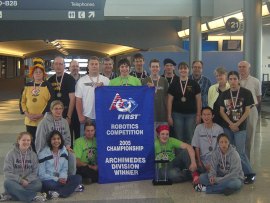2005: Triple Play
In Triple Play, two alliances of three teams each had to place red and blue game tetra game pieces in or on one or more of nine goals to score points and claim “ownership” of the goals
Field
Triple Play was played on a 27 feet by 52 feet field with nine goals spread out in a 3 x 3 matrix similar to that of tic-tac-toe. Alliance stations were on opposite ends with human player zones next to each station. A total of eight “human player loading boxes” were located along the width of the wall where human players were able to feed tetras through.
Game Pieces
The tetras were made from 1.25 inch PVC pipe which had an accumulated length of 30 inches and resembled the shape of a tetrahedral.
Autonomous Period
Teams were able to pre-program their robot to perform certain functions and maneuvers without control of the drivers. Robots could knock down hanging tetras or locate specific “vision” tetras located on the field where teams had a chance to score points and “claim” goals. Teams could perform certain maneuvers as long as those maneuvers followed the game rules and parameters. The autonomous period lasted a total of 15 seconds.
Teleoperated Period
The teleoperated period followed the autonomous period where drivers assumed control of the robots. Drivers from each alliance had the chance to snatch up game pieces from four locations located on the field. Two of these locations were attended and while the other two were not. The teams had to pick up these game pieces and hang them on one of the nine goals located on the field. Before the end of match, the alliances had a chance to speed back to their end zones to score additional points.
Scoring
Tetras that were physically higher than the rest on that goal were scored. If there were no tetras located on the goals then the physically higher tetra in the base stack was counted. If that is not the case, then the alliance with more tetras in the base would be added to the score. These goals were called “claimed” goals. A diagonal or row of “claimed” goals would win the alliance 10 points. Tetras that were in a goal were one point and tetras on a goal were three points. Before the end of the match, if all of the alliance robots were back to their end zone, the alliance scored ten points. All of the points accumulated during the autonomous and teleoperated period counted toward the final score.
Season Recap
Sacramento Regional
- Seeded 5th of all Teams
- 3rd Place Alliance Captains
- Picked Teams 766 and 1072
- 1st place overall!
Detroit Regional
- Seeded 1st of all Teams
- 1st Place Alliance Captains
- Picked Teams 217 and 301
- 1st place overall!
Grand Rapids Regional
- Seeded 23rd of all Teams
- Member of 2nd Place alliance
- Partnered with Teams 27 and 33
- 2nd place overall
Nationals: Archimedes Division
- Seeded 1st of 80 Teams
- 1st Place Alliance Captains
- Partnered with 217 and 766 (Numbers look familiar?)
- 1st place overall!
- Undefeated in Qualifying AND Finals
Nationals: Finals
- Archimedes: 245 (us), 217, 766 3rd
- Curie: 175, 33, 108 4th
- Galileo: 56, 254, 64 2nd
- Newton: 330, 67, 503 1st




